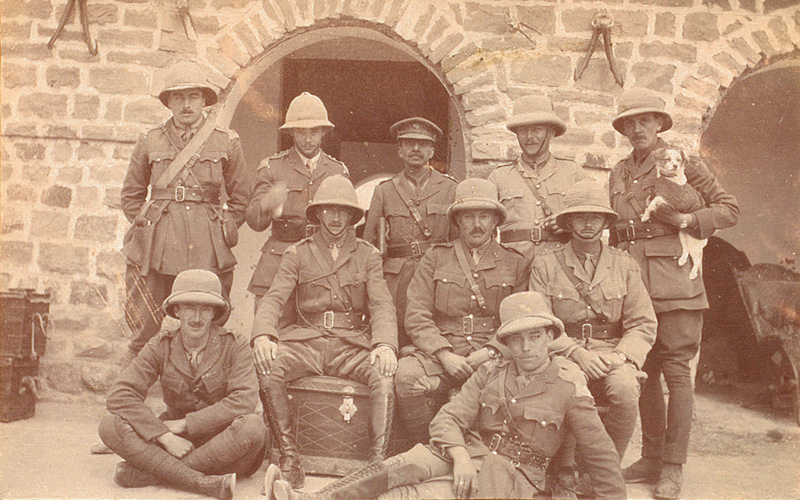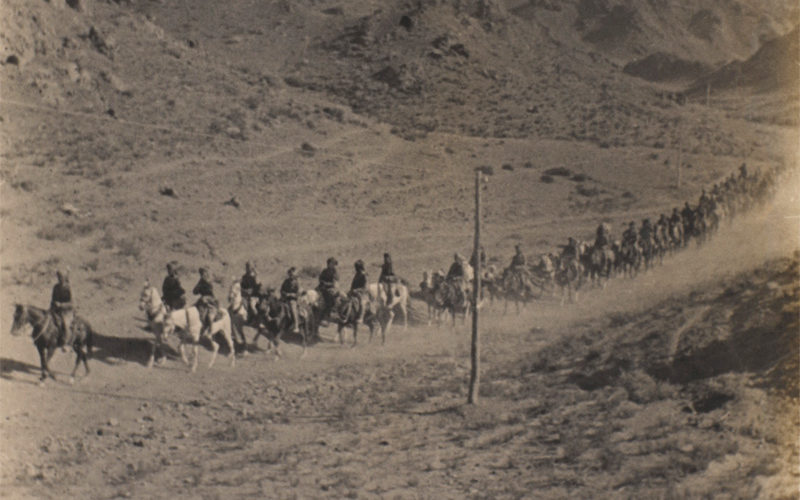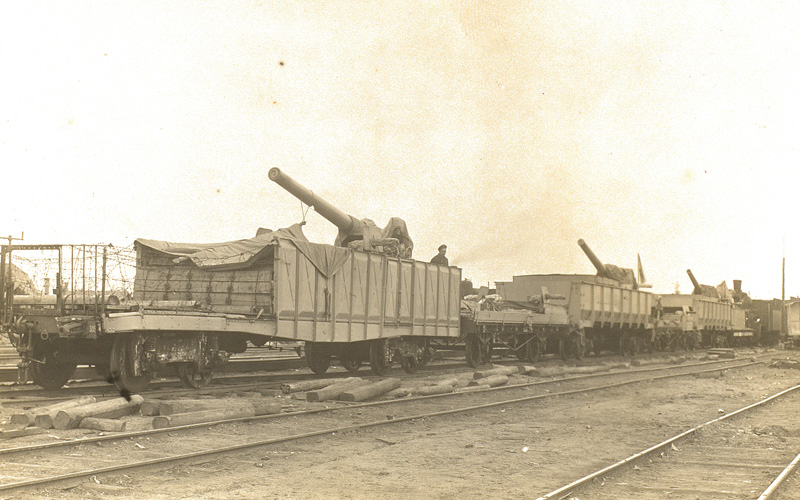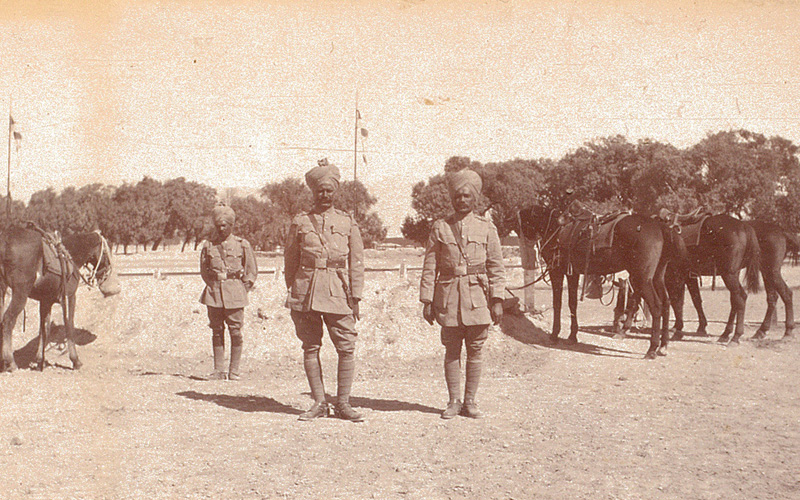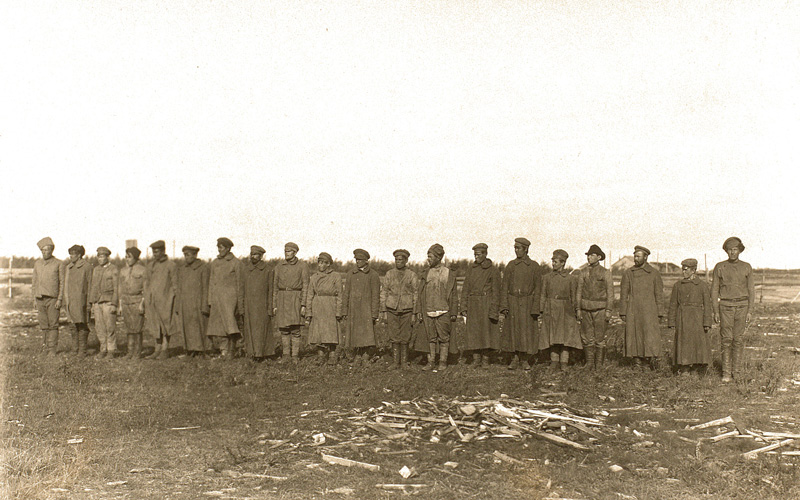Officers of the 28th Light Cavalry (including Uloth on the right of second row) at Meshed, 1918
More details: NAM. 2013-10-7-117
In September 1918, Captain Gerald Uloth and his regiment arrived in Transcaspia in Central Asia to reinforce a British mission tasked with resisting Bolshevik, German and Turkish influence. His letters and memoirs shed light on this largely unknown episode.
Central Asia
British interest in Russian-controlled Central Asia was based on its proximity to its Indian empire and to Persia (now Iran), where it had already established a military and political presence during the war.
As long as Russia was an ally, the situation was satisfactory. But after the Bolsheviks seized power during the October Revolution (1917), and then made peace with the Central Powers (March 1918), the British felt it necessary to bolster their position there and fill the political and military vacuum left by this change.
The thousands of released German and Austrian prisoners of war scattered across Central Asia also raised the spectre of a ready-made army that could be used either to menace India or link up with any Turkish force advancing through the now undefended Caucasus.
Missions
While one mission was sent to the Caucasus, a second, led by General Wilfrid Malleson, was tasked with Transcaspia (now Turkmenistan and part of Uzbekistan) and ordered to ‘combat German and Turkish propaganda’ and stop ‘attempts to organise men, railways and resources towards assisting hostile enterprises, aggression or active operations against us or our Allies’.
In particular, Malleson was told to safeguard the Transcaspian railway by which an enemy could advance eastwards. If this was impossible, he was instructed to destroy it.
As well as safeguarding the approaches to India, the two missions would secure the right or eastern flanks of the British forces fighting in Mesopotamia, now exposed following the Russian withdrawal.
Chaotic situation
By 1918, much of Russian Turkestan, of which Transcaspia was part, was in chaos. Bolshevik rule in this huge region was weak. Their Tashkent Soviet was threatened by Cossack nationalists and various other anti-Bolshevik forces. There were also thousands of released prisoners of war present, pro-Ottoman Turkmen, and roving groups of armed bandits.
Ashkhabad Committee
Malleson was sent from India to Meshed in north eastern Persia and arrived on 16 July 1918. A few days earlier, at Ashkhabad across the border, anti-Bolsheviks had rebelled against representatives of the Tashkent Soviet and established a new Menshevik-dominated government of Transcaspia, also known as the Ashkhabad Committee. This asked the British for assistance and Malleson agreed.
He initially provided a force of Indian machine-gunners for them to resist a Bolshevik attack at Bahram Ali, to the east of Ashkhabad, on 12 August. The anti-Bolshevik units were outnumbered, disorganised and nearly defeated, but the Indian machine-gunners’ fire allowed them to retreat in some order.
Alliance
A formal agreement was made afterwards, in which the British and the Committee agreed to fight the Bolsheviks and oppose Turkish-German penetration of Transcaspia and Russian Turkestan.
In return for keeping it in power with military and financial aid, the British also demanded that the Committee help secure the Transcaspian railway and ban the export of cotton, vital for making uniforms and explosives, to ensure it did not reach the Central Powers.
Opposing forces
On 12 August 1918, Malleson moved 500 men from the 19th Punjabis across the border to reinforce the Transcaspian force, which consisted of around 1,000 men, commanded by ex-Tsarist officers and armed with a variety of old and modern weapons.
‘They are a hopeless crew. The ex-officers won’t lower themselves to work hand-in-hand with the decent class workmen, and these latter fear the officers wish to set up the old regime. In addition, the country is full of free-lancers and adventurers, so it is impossible to raise a satisfactory side against the Bolsheviks… The only stable power in the country are the Turcomen, but they are cruel, and savage, and have little in common with the Russians of either side, and wish to get revenge for the conquest of their country.’
Nevertheless, ‘efforts were made to improve the quality of the troops. Lewis guns were sent out from India and training given in their use’. Their Bolshevik opponents were also a mixed bag of ex-soldiers, released prisoners, workers and peasants. Uloth believed that their best troops ‘were German, Austrian and Hungarian prisoners of war, and as such were trained soldiers’. The Bolsheviks persuaded these men, ‘weary of exile, that by joining their forces they would be able to fight their way home’.
At this point, the Bolsheviks were also better-armed. They attacked again on 28 August 1918 but were repulsed, once more thanks to the Indian troops’ efforts.
Reinforcements
More troops and arms from India were sent via the newly-extended railway line from Quetta to Persia. This was followed by another Bolshevik attack that was beaten off on 11 September. A few days later, another British contingent arrived, including two squadrons of the 28th Light Cavalry from Persia. Uloth recalled:
‘The two squadrons of the 28th Light Cavalry reached Kaaka at the end of September, and not only strengthened the force there but added greatly to its security by long distance patrolling.’
Advance on Dushak
Malleson, against the wishes of the Indian government, then decided to push further into Transcaspia and attack the Bolsheviks. The combined British-Transcaspian force defeated the Bolsheviks at the Battle of Dushak during the night of 13-14 October 1918.
The British-Transcaspian force suffering 60 killed and 180 wounded while inflicting 1,000 casualties on the Bolsheviks. The Anglo-Indian forces did most of the fighting, with the Transcaspian forces proving somewhat unreliable. A bayonet charge by the Punjabi infantry, as well as an attack by the 28th Light Cavalry, eventually drove off the Bolsheviks. Uloth recalled:
‘[The] fighting was heavy, the brunt being borne by the British, who incurred some 150 casualties. The Bolshevik losses were far heavier, and the rough handling they had in this action combined with the pressure by the cavalry on their flanks caused them to withdraw as far as Ravnina a station some 30 miles [48km] to the east of Merv.’
The Bolshevik forces retreated with their trains to Dushak and then pulled back further to Merv which they eventually evacuated. The British and Transcaspian forces occupied it soon after.
A train war
Trains played a vital role in the fighting as roads were few and water was scarce. Troops were dependent on trains for movement, supplies and water. Uloth ‘lived and traveled in every conceivable form of vehicle, armoured trains, engines, cattle trucks, saloon carriages and hospital trains’. He described a typical armoured train:
‘No 1 Armoured train is well built, having been armoured with steel plates at the railway workshops at Kizil Arvat. To prevent the vital portions of the train being blown up by land mines, two flat trucks loaded with pig iron and ballast approximating the weight of an engine are coupled in front. The next vehicle is a flat truck mounting a howitzer, on which is fixed a most ingenious device for taking the recoil, and for preventing the trail of the gun from being driven through the bottom of the truck on discharge…
‘Behind the howitzer truck comes a large armoured waggon, from the front of which peeps out the muzzle of a field gun, the train’s chief armament. The sides of this vehicle are loop-holed for the two machine guns which it also carries. There being no tunnels on this railway, height is no object, and on the roof of the gun waggon a small bridge has been constructed, protected by steel plates and sand bags. From this the train commander directs his fire, and controls his engine by signal. He pulls a string, which rings a bell in the cab. The engine, well armoured, is coupled behind the field gun waggon, and behind the engine are two armoured waggons for the crew.
‘In addition to the crew there are some Turcomen, who act as cooks and servants, and join in the fighting if required… The Bolsheviks also live in trains, even their cavalry entrain at night, and jump their horses out of the waggons in the morning.’
Sometimes, trains engaged each other, the one with smaller guns usually being driven back by its opponent. Both sides also blew up rail lines and bridges to hamper enemy movements. Uloth recorded that one of ‘ours went sky high in three places the other day; yet trains were running over it within the hour’ thanks to the ‘expert railway men’.
Extreme conditions
The campaign was fought in a very harsh climate and in unforgiving terrain:
‘I have also experienced every kind of inclement weather imaginable, snow, rain, raging winds and violent dust storms… One day I went out on patrol and lost direction in a dust storm, and found myself right behind the enemy’s line and their position at Ravnina station. I saw their armoured trains quite well, also some cavalry, I think Austrians, so pushed off back into the desert.
‘The front is in a vast waterless sandy desert of rolling sand hills and scrub; all water has to come up by train. Once you have left the landmarks of camp behind you, and are out in the desert, it is difficult to keep direction except by compass. The desert rolls away in these low sand hills on every side like the billows of the sea. The view from whatever sand hill you stand on is the same, and there are no features from which to gauge your position. The going is heavy, and as the ground is pitted with marmont holes, movement at speed for cavalry is precarious.’
Policy change
On 30 October 1918, the Ottoman Empire signed the Armistice of Mudros with the Allies. Twelve days later, Germany also accepted peace terms, ending any possible threat to the British position in Central Asia. Peace also removed the problem of the German and Austrian prisoners, who were now given assistance to return home.
But Malleson was determined to strengthen British prestige and advance further, which was against the wishes of both the British and Indian governments who told him to halt. He also felt morally obligated to aid the Ashkhabad Committee. The order not to advance angered some of the officers who were on the spot:
‘After the action at Dushak and the subsequent retirement to Churjui, the Bolsheviks were in no condition to resist our forces… The morale of our troops after frequent encounters with the enemy was high. It would have been easy to drive the Bolsheviks over the River Oxus and to have made a strong position at Churjui. The country could have been held in comparative safety, or a further advance made…
‘The war with Germany ended in November with the Armistice, and the policy dictated from home was “no further commitment in Russia”. The British were not allowed to advance another yard or take any offensive action.’
Security duties
Although Malleson used his troops to help maintain law and order in Ashkhabad, he was also forced to stop paying money to the Committee, who soon lacked the cash to pay the salaries of officials and railways workers. Food supplies also declined. Public discontent with the Committee grew, as did secret Bolshevik agitation and labour unrest. Uloth witnessed the deteriorating situation:
‘At the beginning of December it became apparent that there was a serious danger of a rising in Ashkhabad. All our sick and wounded in that town were issued with rifles and ammunition. Owing to lack of funds, the position of the Transcaspian Republic was becoming precarious, the unpaid railway men were clamouring for pay, and Bolshevik sympathisers behind the line were taking advantage of these conditions to prepare the way for revolt… ‘B’ Squadron, 28th Light Cavalry… and three companies of the Warwicks… had been brought into Ashkhabad, and any anxiety as to a rising in the rear was effectually dispelled.’
In the following weeks, the Committee was replaced by a new Committee of Public Safety. This short-lived dictatorship was itself eventually replaced by representatives of General Anton Denikin’s White Army. His forces also gradually took over the Transcaspian military.
Fight at Annenkovo
Meanwhile, the Bolsheviks attacked again on 16 January 1919 at nearby Annenkovo. The battle was fought in thick fog which led to a confused action. Reinforcements had to be hurriedly brought up by train from Bairam Ali. But, thanks to the Indian troops, the attack was defeated. Casualties among the latter were 46, among the Transcaspian force 70, while Bolshevik losses were over 1,000.
‘Owing to the British policy of non-aggression, the Bolsheviks recovered their morale. On 16 January, they attacked the Annenkovo position with very strong forces. The front was held with difficulty until reinforcements arrived from Bairam Ali. Fortunately, the assault was made on a relief day when the troops present were double the usual number, otherwise the affair might have been critical.’
Quiet front
After Annenkovo, the front settled down with little activity beyond sporadic shelling, sniping and patrolling.
‘The front is fairly quiet now. The Turcomen go out and do a little scrapping from a safe distance, and there is desultory shelling daily, just a few rounds. The shells fall very wide of our camp and positions… The Bolsheviks are very cheerful, and sing and make merry into the night with wine, music and their lady friends, who are numerous and come forward into the advanced posts; several of the latter have been killed in the fighting… It has always been my fate to take part in obscure and strange expeditions, but this really defeats everything. I am overwhelmed by it all.’
Withdrawal
Despite still arguing for greater British involvement, Malleson was now under growing pressure to withdraw. In order to do this safely, he spread a rumour that the British withdrawal was a feint for a flanking attack. The Bolsheviks were fooled by the ruse, and responded to the rumour by reinforcing their positions rather than pursuing the British troops, who had all left by mid-April 1919.
However, with the British gone, the Bolsheviks launched new offensives, re-taking Merv and gradually pushing the Transcaspian forces back until Ashkhabad was abandoned in July 1919. The anti-Bolsheviks were finally defeated by 1920 and the Tashkent Soviet regained full control of the territory.
Assessment
The mission made little difference in terms of the First World War’s outcome or the perceived threat to India. By the time it arrived in theatre, Germany and Turkey were already losing the war and unable to cause much trouble in Central Asia.
British intervention certainly prolonged the life of the Transcaspian government. Without British assistance, it would have collapsed quickly in the face of Bolshevik attacks. At the same time, intervention forced the Tashkent Soviet to divert troops to the Ashkhabad front, greatly assisting other anti-Bolshevik forces fighting elsewhere in Central Asia.
A difficult job
The men involved in the mission struggled with a harsh environment, and faced extraordinarily long and difficult lines of supply and communication that ran from India, up through eastern Persia to the border of Russia, and then on to Ashkhabad and Merv.
They also faced a confused political and military situation, worked with uncertain allies, and at times operated under inconsistent instructions from the government they served.
Biography
Gerald Uloth (1893-1973) was born at St Johns Wood in London on 27 December 1893. He was the son of a Frenchman, Herman Wilmot Uloth, and his English wife Susan Harriet Spall. His father was a general manager with the P&O Shipping Company, and Gerald spent his earliest years in Bombay, before travelling to England in 1897.
Gerald had an elder sister, Amy Christina, and an elder brother Alexander Wilmot, who went on to serve with the Royal Army Medical Corps during the First World War. In 1901, the family was living at 168 Godstone Road, Kenley, Surrey. Gerald was educated at Radley College in Oxfordshire. By 1911, the family had moved to Great Tylers, Wray Common, Reigate, Surrey.
That same year, Gerald entered the Royal Military College Sandhurst. On graduating, he joined the Indian Army, attracted to the force after seeing Indian cavalry units parading at King George V’s coronation celebrations.
In December 1912, he boarded ship for Bombay as a second lieutenant on the Indian Army Unattached List. After serving for six months with the Royal Irish Fusiliers in Quetta and six months with the 21st Lancers in Rawalpindi, he was posted to the 28th Light Cavalry in January 1914.
For the first year of the war, Uloth’s regiment was stationed at Quetta where it trained new recruits and horses. But in June 1915, the 28th Light Cavalry were posted to Persia, travelling through the deserts of Baluchistan to help form a cordon along its eastern border against German and Turkish agents who were intent on encouraging anti-British unrest in Afghanistan and on the North West Frontier of India. Gerald saw much action in these areas, carrying out patrols and engaging in skirmishes against rebellious tribesmen.
Following the Russian collapse in 1917, British forces, including the 28th Cavalry, took over their former allies’ area of responsibility in northern Persia as well, and then moved on into Russian territory to prop up anti-Turkish and anti-Bolshevik forces in Transcaspia.
After accompanying the Malleson Mission back to Meshed, the 28th Cavalry remained there, escorting convoys for several months. It then took part in the Third Afghan War (1919) and the operations to suppress the tribal revolt in Waziristan (1919-20). It finally returned to India in November 1919.
In 1922, Uloth’s regiment was renamed the 7th Light Cavalry. On 6 October that same year, while on leave in England, he married Barbara Maude Crickmay at St Mary’s Church, Reigate. The couple returned to India, but ill health forced Uloth to retire from the service in 1931 with the rank of major, having received the 1914-15 Star, British War Medal, Victory Medal and Indian General Service Medal.
After a year working as the manager of a pipe factory in Spain, he returned to England along with his wife and two sons, Peter and Anthony, settling in Kent where he farmed chickens. In 1939, he was living at ‘Burnt House’, Cranbrook, Kent.
The following year, Gerald was recalled to the Indian Army. He worked as a military adviser to the Indian State Forces until 1942, when he was discharged as medically unfit.
On returning home, he served as a commander of his local Home Guard unit, head air-raid warden and chairman of his parish council.
A keen yachtsman, after the Second World War he moved with his wife to Woodbridge on the River Debden in Suffolk, settling at ‘Red Maltings’, Kingston Road. He died there on 17 February 1973.
Explore further
- Article: Explore more Soldier Stories
- Article: Sykes Mission to Persia
- Article: Dunsterforce in the Caucasus
- Article: Explore more First World War stories
Explore the map for similar stories
Captain Gerald Uloth - Woodbridge, Suffolk
 First World War in Focus
First World War in Focus